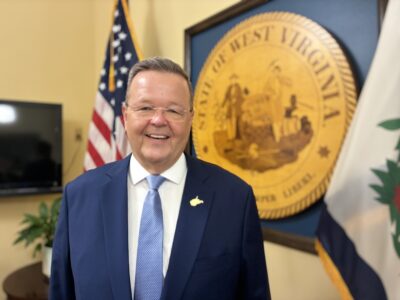Morrisey’s first budget revenues come in above projections
CHARLESTON — July marked the start of fiscal year 2026 and the start of Gov. Patrick Morrisey’s first general revenue budget since taking office in January, with the final revenue numbers released for the previous fiscal year, prompting a statement from West Virginia’s former governor and current U.S. Senator.
According to reports released Friday by the state Department of Revenue and the Senate Finance Committee, West Virginia ended July – the first month of the new fiscal year – with $388.2 million in tax collections, which was 6.1% above the $365.9 million projection set by the governor’s revenue officials and nearly 16% above the $335.3 million in tax collections at the end of July 2024.
July’s tax collections provided the state with $22.3 million in tax collections over and above the estimate. Leading the way on the state’s tax collections in July was personal income tax and corporate net income tax collections.
July personal income tax collections of $148.4 million were 6.1% above the $140 million revenue estimate and 3.9% above July 2024 collections of $142.9 million, providing a $8.5 million surplus for the month.
“July 2025 collections included roughly $11 million in receipts associated with a recently enacted law eliminating a payment acceleration requirement for certain Taxpayers,” the Department of Revenue said in a press release Friday. “By comparison, July 2024 collections were enhanced by more than $7.1 million because of a decision to pay some tax refunds out of the Personal Income Tax Refund Reserve Account.”
July corporate net income tax collections of $22.3 million were 69% more than the $13.2 million estimate and 17.5% above July 2024 collections of $119 million, providing a $9.1 million surplus for the current fiscal year.
Dragging down West Virginia revenue numbers in July was the consumer sales and use tax and the severance tax on coal, oil and natural gas. Sales tax collections for the month of $136.8 million were 2.9% below projections. However, when compared to July 2024, sales tax collections were 47.5% more than last year’s $92.7 million in collections. July severance tax collections of $1.4 million were 59% below the $3.5 million projection and 54% below July 2024 collections of $3.1 million.
The West Virginia Legislature passed – and Morrisey signed – a $5.323 billion general revenue budget for fiscal year 2026, which began on July 1 and continues through the end of June 2026.
The state ended fiscal year 2025, which ended on June 30, with $5.519 billion in collections for the general revenue fund and $254.8 million in surplus tax revenue. In a separate press release Friday Morrisey said the total end-of-fiscal year surplus – once all the books were closed out – was closer to $338 million.
Of the additional monies, $49.2 million was from prior fiscal year unspent surplus tax collections and other unappropriated balances left over at the end of fiscal year 2025, as well as $34.2 million in expirations of year-end general revenue fund appropriations. According to the Governor’s Office, the expiration amount at the end of the previous fiscal year was larger than previous expirations over the previous 16 fiscal years.
Morrisey credited the larger-than-previously-announced surplus for fiscal year 2026 to prudent fiscal management upon taking office in January and over the past six months.
Morrisey signed an executive order on Jan. 14 requiring cabinet secretaries and department heads to review all expenditures for the final six months of the previous fiscal year and report any expenditures more than $100,000. Another executive order required state departments and agencies to identify areas of inefficiency and wasteful spending and create plans to address those issues.
“I know that when I came in on day one, I issued an executive order to begin looking for the kind of savings that we need, and it’s paying off,” Morrisey said Friday during a press conference in St. Marys. “We’re saving money, we’re running government more efficiently, and we’re making decisions to say when we’re going to spend money, let’s make sure we spend it on the things that really matter and drive economic growth.”
But much of the $338 million is already spent, with lawmakers approving more than $126.2 million in supplemental appropriations spending available surplus dollars during the 2025 legislative session earlier this year. Another $100 million will go to the Division of Highways for road maintenance and paving projects as required in the surplus section in the back for the fiscal year 2026 budget, which appropriates available surplus dollars available at the end of the previous fiscal year.
“The state finished with a surplus, and we had a lot of good work with the Legislature,” Morrisey said. “But also, we were able to make a lot of the tough decisions that actually is going to allow some of that surplus to roll over. Some of it is already allocated for important things. But these are big, tough decisions that you make.”
Morrisey also credited using his line-item veto authority for the fiscal year 2026 budget, cutting or reducing 29 line items to the tune of approximately $37.7 million.
When Morrisey first took office in January, his incoming revenue officials projected a nearly $400 million gap in fiscal year 2026 spending versus revenues in an early six-year budget forecast. The “hole” was attributed to the influx of federal funding due to COVID-19 and other monies, combined with overreliance on one-time monies.
“The fiscal and the structural problems that we identified were always for the period of July 1, 2025, through June 30, 2026,” Morrisey said. “In the budget process, we were able to make significant inroads in addressing that.”
U.S. Sen. Jim Justice, the previous two-term governor of West Virginia, has taken issue with Morrisey’s earlier projections for fiscal year 2026 and aspersions that he was leaving the state with budget shortfalls.
“It ain’t bragging if you’re right, and I’ve said it time and time again: our state was left in spectacular financial shape upon my departure from the Governor’s office – this surplus proves it,” said Justice, R-W.Va. “Many critics, perhaps blinded by ambition or simply saying there is a problem in order to fix it, are now waking up to the realization that I was correct from the beginning – better late than never!”
While the fiscal year 2026 general revenue budget is balanced, expenses outpace revenues beginning in fiscal year 2027 and going forward according to the six-year budget forecast. Major expenses include the Hope Scholarship educational voucher program, which will be open to all public, private, and home school students in the state in fiscal 2027. The cost of Hope and other programs could come to and additional $200 million. Future healthcare costs for the Public Employees Insurance Agency could grow by an additional $35 million in fiscal year 2027.
“Some of those problems still are out there, but we’re making the kind of decisions, the tough decisions, in order to position West Virginia effectively,” Morrisey said. “We have a great optimistic future, but we do still have some real challenges with some of the increases expected in those programs.”
(Adams can be contacted at sadams@newsandsentinel.com)



